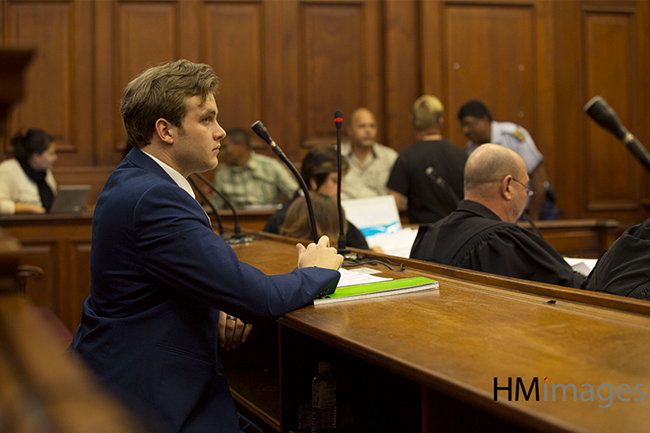The van Breda triple murder trial is in its third week and a new witness took to the stand for day 11.
An interesting observation was that of Henri’s demeanour; he was visibly more cheerful than he has previously been during the trial, sporting a new suit and haircut – coincidentally on a day when the bulk of the proceedings were centered on the forensic subject of hair found at the crime scene.
Colonel Henry Stewart, a forensic expert based in Pretoria, provided what the state had presumably thought was damning evidence against the accused based on hair samples he had analyzed. A photo was at the centre of day-long evidence and testing thereof, of Marli’s hand, which was taken at the crime scene, and that clearly displayed her clasping a strand of blonde hair. Colonel Stewart’s testimony revealed that the hair could have only been forcibly removed from somebody’s head, as opposed to it having been naturally shed.
He also revealed that as part of the forensic process, he refers to kit numbers and not the names associated with each specimen of hair, in order to ensure his findings remain objective. One of the day’s biggest talking points was that there appeared to be strands of hair, included in the 14 examined from the crime scene, which did not resemble any of the specimens taken from each member of the van Breda family. A rigorous line of questioning by Advocate Botha ensued.
You understand the role of an expert witness? Yes u understand that you aren’t here to advance the prosecutions state?@CapeTownEtc #vanbreda
— Tracey Stewart (@Traceyams) May 15, 2017
Colonel Stewart had omitted to mention in his report that there were strands of hair found at the scene which did not resemble those of the family members and when pushed on this, told the court that he had implied this and did not feel it was necessary to say this expressly. Advocate Botha warned Stewart that he would later argue that Stewart was intentionally trying to mislead the court by failing to expressly record important findings when submitting a section 212 statement (a statement administered under oath which can be accepted by the court as prima facie evidence). Stewart did not have anything believable to submit in support of his reasoning and Judge Desai noted this. It is thus safe to assume that Judge Desai will tread carefully when considering any of the evidence given by Stewart.
After excellent cross-examination by Advocate Botha regarding the blonde hair found in Marli’s grasp, Stewart abandoned his own report findings by conceding that the strand of hair in question was simply too long to have come from Henri’s head. His hair at the time, as evidenced by a photo taken the day of the murders was no longer than 30mm in length and the length of his sample taken a few months later no longer than 50-80mm. The hairs found in Marli’s hand were at least 200mm.
Advocate Botha put it to Stewart that had he seen a photo of Henri’s hair at the time, and asked if he would have been immediately able to exclude Henri’s hair as resembling that of the hair found in Marli’s hand, to which Stewart agreed he would have. After noting that it was strange the state did not provide him with a photo, Advocate Botha then persisted, asking Stewart what the chances were that the strands of hair had indeed come from Henri’s head. “Very slim” replied Stewart, to which Botha bellowed back with “I would say nil!”.
Adv Botha tells Stewart that his evidence is NB he can’t state something as fact and then say he isn’t certain @CapeTownEtc #vanbreda
— Tracey Stewart (@Traceyams) May 15, 2017
Following this, Stewart was then accused of providing a misleading affidavit and creating false impressions – ultimately giving evidence which appeared to advance the state’s case. Botha reminded him of how serious this is.
We expect another analyst, this time from Beaufort West, to take the witness stand at day 12.
Follow Tracey Stewart on Twitter for live, to-the-minute-updates from the courtroom.






